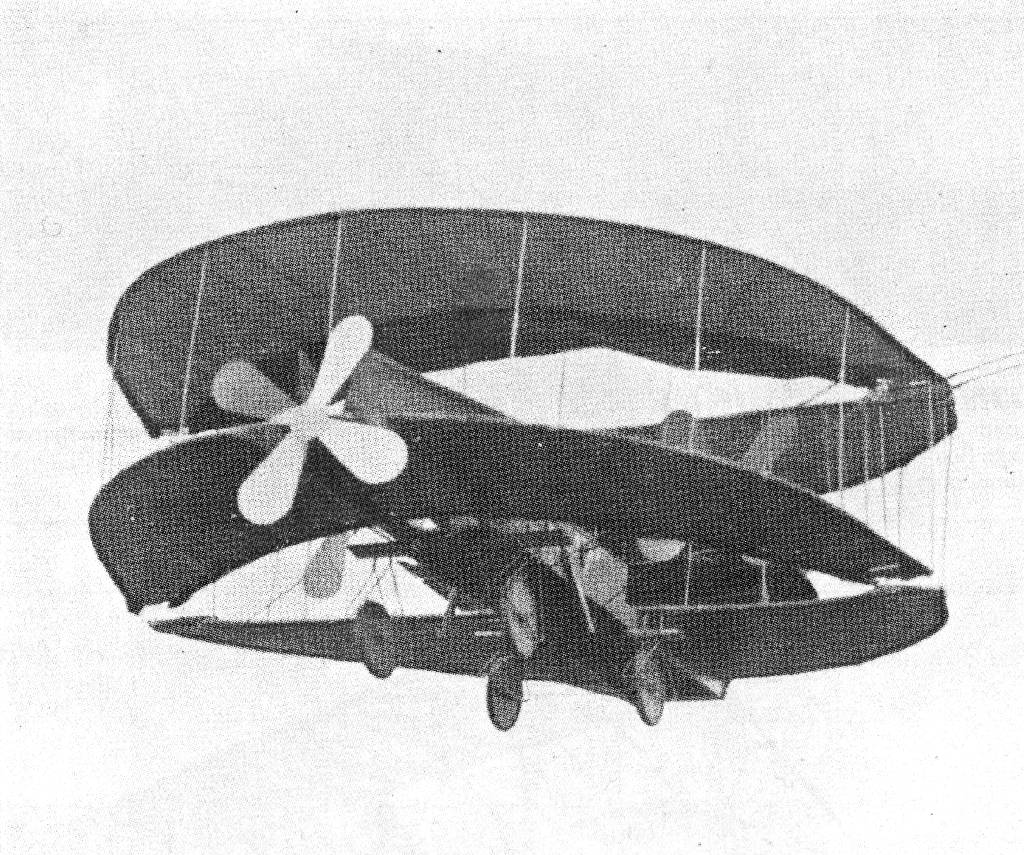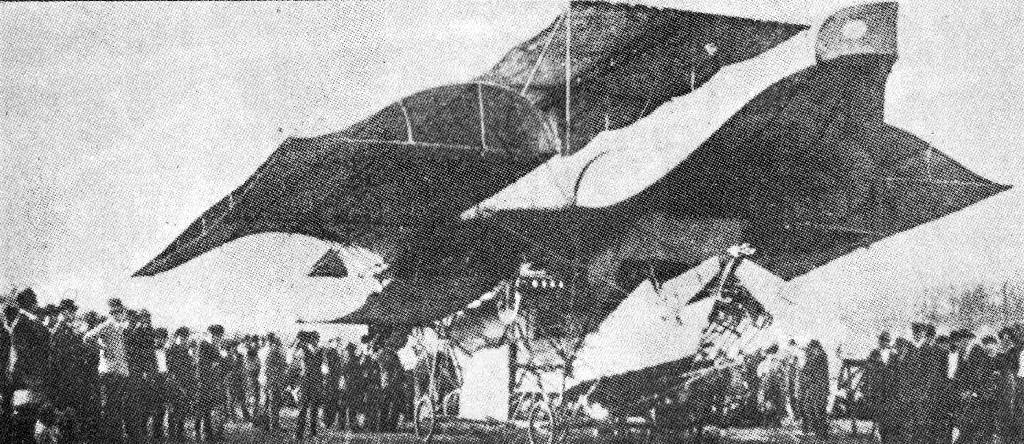


All the World's Aircraft, by Various
|
mis à jour / updated :
|
|
 |
 |
 |
| HOME
|
INDEX | Extrait
de http://www.gutenberg.org/
All the World's Aircraft, by Various |
| Les AVIONS AVANT 1910 | ||
| |
AUSTRIAN
BELGIAN BRAZIL BRITISH DANISH FRENCH GERMAN ITALIAN SWISS U.S.A. |
| AUSTRIAN | WELS & ETRICH (1908).
Original form of the modern Etrich (q.v.). HIPSSICH (1908). Tandem mono. with one propeller before and another in rear of rear plane. NEMETHY (1908). The first "Aviette." SOLTAU (1910). An ornithopter based on the earlier ideas of Adehmar de la Hault (see Belgium). |
| BELGIAN | DE LA HAULT (1907). One of the
earliest attempts at an ornithopter. No flights. DE LA HAULT II. (1910-11). The ornithopter principle applied to a monoplane. No success met with. D'HESPEL (1909-10). Single plane and suspended body. Early example of enclosed body. No flights. |
| BRAZIL | SANTOS-DUMONT XIX. This little machine, surface only 9 m². made an extraordinary sensation in France in 1909. It flew at the then incredible speed of 65 m.p.h. (100 k.p.h.) Santos-Dumont presented all rights to the world soon afterwards, and a large number were built before it was realised that only an extremely light weight pilot could fly in one. Few of the copies ever left the ground. |
| BRITISH |
AVRO (1906). This 24 h.p. biplane,
designed by A. V. Roe, was the first British machine to
leave the ground. AVRO (1907). Tractor triplane of only 9 h.p. This flew in Lea Marshes—the lowest horse power yet flown in Europe to the present day. CODY (1909). Development of a much earlier machine. This one was a general laughing stock for a long time; but it was the direct predecessor of the machine (not very materially different) which was an easy first in the British Army aeroplane trials, 1912. DE HAVILLAND (1909). The performances of this machine secured a Government appointment for its aviator-designer. HOWARD WRIGHT (1908-09). The first machine in the world in which special attention was paid to securing a stream line body and minimised wind resistance. HUMPHREY (1908-09). Earliest British attempt at a hydro-aeroplane; possibly the earliest design ever produced anywhere. HUNTINGDON (DUNNE II) (1910). One of the earliest aeroplanes in existence—designed by Captain Dunne about 1905-06, previous to the secret experiments of the British War Office in Scotland, on the Duke of Atholl's estate. Assigned to Prof. Huntingdon in 1910. Made a few short flights. PORTE (1908). Designed by Lieut. Porte, R.N., in conjunction with Lieut. Pirrie, R.N. This machine, on which the former well known aviator commenced his flying career, was smashed up in preliminary trials as a glider on Portsdown Hill, Portsmouth. Its design apparently preceded the Goupy in the use of staggered planes. "SAFETY" (1909-10). SEDDON. (1910). Designed by Lieut. Seddon, R.N. SHORT (1910). The first machine to Short's own design. (The tail here shown is a specially large one fitted by Moore-Brabazon). VALKYRIE (1910). This was one of the first "tail first" machines to be designed. The experimental machine (also known as the A.S.L.), was completed in Feb., 1910. |
| DANISH | ELLEHAMMER (1905). On 12th September,
1906, this machine made the first free flight in Europe.
On 28th June, 1908, it won the prize at Kiel for the
first flight in Germany (distance, 47 m.) It was a
tractor biplane with a revolving Ellehammer motor. It
also had a pendulum seat as a stabilising device. |
| FRENCH |
ANTOINETTE IV (1909). In this machine
Latham made the first attempt to fly the Channel, 19th
July, 1909. BLERIOT IV (1907-8). In 1909 the famous Bleriot XI was built. This did very well at Reims, 1909. On 25th July, 1909, Bleriot made the first Cross-Channel flight in the machine illustrated below. Bleriot XI. This machine had length, 23 feet (7 m.) Span, 25¾ feet (7.80 m.) Area, 167 sq. feet (15½ m².) Aspect ratio 4½ to 1. Motor, 22-25, 3 cylinder Anzani. Speed, about 45 m.p.h. (73 k.m.) Special features: Fixed wings with rounded edges. Twin elevator and fixed surface tail. BOUSSON-BORGNIS (1907-08). BREGUET (1906). The first Breguet, known as Breguet Gyroplane I. Made a flight in October, 1906, being the first helicopter to leave the ground. BREGUET-RICHET II bis. (1909). A large and unsuccessful development of the gyroplane. BREGUET IV (1910). On its appearance, this machine was generally laughed at and nicknamed the "Coffee Pot," till in Aug., 1910, it made a world's record by carrying six, and later proved itself superior in stability to anything then existing. CHAUVIÉRE (1909-10). Attempt to develop a monoplane with propellers in rear. The idea has been resuscitated for some 1913 military monoplanes. COLLOMB (1907-09). Ornithopter, from which great things were once expected. CORNU (1908). An early helicopter for which flights were claimed, but have also been denied. D'EQUIVELLY (1907-08). Interesting example of the strange machines devised by pioneers. H. FARMAN (1907). This famous machine is the first Voisin, and the one on which H. Farman taught himself to fly. It was the first machine to make a turn in the air. Won the Deutsh-Archdeacon Grand Prix, 13th January, 1908, with a flight of 1 minute, 28 seconds. The extra third plane was added later. An Austrian Syndicate subsequently bought the machine. H. FARMAN (1908). Farman's first idea of a monoplane. It proved too heavy to fly with the power provided. Was eventually sold to a German officer. Three sets of wings and entirely enclosed body. GABARDINI (1909-10). Very early hydro-aeroplane, antedating the Fabre. GIVAUDIN (1908-09). Built by the Vermorel Co. The first conception of an idea which has since attracted a certain class of inventor in Germany, Italy and the U.S.A. MILITARY (1909). The first special military aeroplane ever built. It was specially designed by Capt. Dorand, for what were then held to be the aerial necessities of the French Army. The planes were placed well above the body, giving the pilot a very clear uninterrupted view. PISCHOFF-KOECHLIN (1906 or earlier). Dates from the days when a box-kite was the elementary idea in design, and the accepted position of the aviator lying prone. PISCHOFF-KOECHLIN (1908). Very early example of a tractor biplane. The extra span of the upper plane is also of interest. The machine had twin mono-elevators aft and also twin rudders. R.E.P. (1908). Early example of enclosed stream line body. Apparently the first machine in which steel construction appeared. VOISIN (1908). The first European aeroplanes to fly with any real success. VUITTON-HUBER (1908). Early helicopter. VUIA (1908). Earliest known machine with folding wings. WITZIG-LIORE-DUTILLUEL (1908-09). First or one of the first appearances of the idea of a series of staggered planes, with which Sellers has ever since experimented in the U.S.A. |
| GERMAN | BEILHARZ. (1909). First design in which a
completely closed in body figured. GEISLER (1908). GRADE (1908). The first German built machine to fly. LORENZEN (1908-09). PARSEVAL (1909). Early hydro-aeroplane. Specially designed for military purposes by Major Parseval. SCHOLTZ (1908). Never left the ground. |
| ITALIAN | MILLER (1908-09). First aeroplane to be
designed and constructed by Italians. |
| SWISS | DUFAUX (1908-09). First Swiss machine. |
| U.S.A. |
BOKOR (1909). The third American machine
to leave the ground; the second purely U.S. one. CALL II (1909). CYGNET II (1908). Designed by Dr. Graham Bell, of the Aeronautical Society of America. Bell (Canadian), Glen Curtis (U.S.), Herring (U.S.), and Burgess (Canadian). It made short flights. ENGLISH (1909). In 1909 extraordinary claims were made for this machine and great things expected. On a full power trial in its shed it broke loose, and smashed itself against the roof. No recorded outdoor results. HERRING-BURGESS (1910). HULBERT (1910). This strange machine built in Switzerland by Dr. Dane Hulbert, achieved several flights. The planes were placed longitudinally instead of in the usual way. JUNE BUG (1908-09). Famous machine of its era. Built by the Aeronautical Society of America (see Cygnet II). Second machine to fly in the U.S.A. Did 2000 miles before being broken up. KIMBALL (1909). First machine in which a large number of propellers was attempted. Failed. LOOSE (1910). LUYTIES OTTO (1908). MOISSANT (1910). Built entirely of aluminium. Designed by the late John Moissant. Failed. RICKMAN (1908). ROSHON (1908). WILLIAMS (1908). ZERBE (1909). WRIGHT (1908). Two views of the machine with which Wilbur Wright startled all Europe from August, 1908 to April, 1909. First U.S. machine to fly. |























In 1909 the famous Bleriot XI was built. This did very well at Reims, 1909. On 25th July, 1909, Bleriot made the first Cross-Channel flight in the machine illustrated below.

This machine had length, 23 feet (7 m.) Span, 25¾ feet (7.80 m.) Area, 167 sq. feet (15½ m².) Aspect ratio 4½ to 1. Motor, 22-25, 3 cylinder Anzani. Speed, about 45 m.p.h. (73 k.m.) Special features: Fixed wings with rounded edges. Twin elevator and fixed surface tail.












































